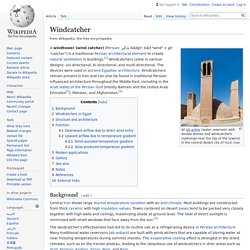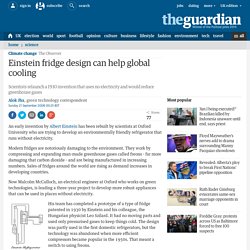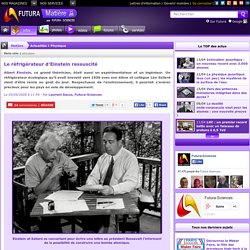

Windcatcher - Wikipedia. An ab anbar (water reservoir) with double domes and windcatchers (openings near the top of the towers) in the central desert city of Yazd, Iran A windtower (wind catcher) (Persian: بادگیر bâdgir: bâd "wind" + gir "catcher") is a traditional Persian architectural element to create natural ventilation in buildings.[1] Windcatchers come in various designs: uni-directional, bi-directional, and multi-directional.

The devices were used in ancient Egyptian architecture. Windcatchers remain present in Iran and can also be found in traditional Persian-influenced architecture throughout the Middle East, including in the Arab states of the Persian Gulf (mostly Bahrain and the United Arab Emirates[2]), Pakistan, and Afghanistan.[3] Background[edit] Central Iran shows large diurnal temperature variation with an arid climate. The windcatcher's effectiveness had led to its routine use as a refrigerating device in Persian architecture. Windcatchers in Egypt[edit] Structure and architecture[edit] Passive Vaccine Storage Device. Eco Cooler.HowToMake. ClayTech.
ZEER POT / REFRIGERATION POT DANS POT. REFRIGERATION BY ADSORPTION / RÉFRIGÉRATION PAR ADSORPTION. Maitrise - Différent types de rafraîchissement d'enceintes. The Guardian - Einstein Fridge. An early invention by Albert Einstein has been rebuilt by scientists at Oxford University who are trying to develop an environmentally friendly refrigerator that runs without electricity.

Modern fridges are notoriously damaging to the environment. They work by compressing and expanding man-made greenhouse gases called freons - far more damaging that carbon dioxide - and are being manufactured in increasing numbers. Sales of fridges around the world are rising as demand increases in developing countries. Now Malcolm McCulloch, an electrical engineer at Oxford who works on green technologies, is leading a three-year project to develop more robust appliances that can be used in places without electricity.
His team has completed a prototype of a type of fridge patented in 1930 by Einstein and his colleague, the Hungarian physicist Leo Szilard. Einstein and Szilard's idea avoids the need for freons. At one side is the evaporator, a flask that contains butane. Futura-Science -Le réfrigérateur d'Einstein. Einstein et Szilard se concertant pour écrire une lettre au président Roosevelt l'informant de la possibilité de construire une bombe atomique.

Le réfrigérateur d'Einstein ressuscité - 2 Photos Albert Einstein n’était pas que l’immortel découvreur de la théorie de la relativité générale et l’un des principaux fondateurs de la mécanique quantique. Même si on ne peut le comparer à un Enrico Fermi, aussi à l’aise avec la théorie qu’aux prises avec une expérience, on lui doit aussi quelques travaux en physique expérimentale, comme l’expérience de Einstein-de Haas et surtout, le brevet d’un réfrigérateur utilisant de l’ammoniac, déposé avec Léo Szilard, l’un des pères de la théorie de l’information en thermodynamique statistique et le premier à comprendre qu’une réaction en chaîne de l’uranium était possible. Sans doute ne faut-il pas oublier qu'Einstein avait commencé à gagner sa vie comme employé du bureau de l'Office des brevets en Suisse.
Cliquez pour agrandir. Le principe en est simple. Powerless refrigerator keeps food cold through evaporation. Sometime in your life you have probably experienced very primitive means, whether through camping or just a power outage, you have (hopefully) had the cognitive awareness of wondering ‘how do we save the food?’

See in camping you plan for it, dry foods only, ice down any meats to prevent spoiling. If your electricity goes out, everyone in the house knows not to open the refrigerator, preserving the coldness to prevent the food from spoiling. I’ts easy to take that accessibility (for us anyways) to chill our foods for granted, but for 1.3 billion people in the world, that is not even an option. The Biomimicry Global Design Challenge in Canada challenges students and researchers to be inspired by nature and come up with solutions to improve the global food system.